Effects of Grinding Methods of Tartary Buckwheat Leaf Powder on the Characteristics and Micromorphology of Wheat Dough
Abstract
:1. Introduction
2. Materials and Equipment
2.1. Materials
2.2. Preparation of Mixed Powder, Dough, and Protein
2.2.1. Preparation of Mixed Powder
2.2.2. Preparation of Dough
2.2.3. Extraction of Dough Protein
2.3. Determination of Particle Size of Tartary Buckwheat Leaf Powder
2.4. Determination of Dough Rheological Properties
2.5. Determination of Hydration Properties
2.6. Free Sulfhydryl (-SH) Content
2.7. Fourier Transform Infrared (FTIR) Spectroscopy Analysis
2.8. Fluorescence Spectrum Analysis
2.9. Scanning Electron Microscope (SEM) Analysis
2.10. Statistical Analysis
3. Results and Discussion
3.1. Analysis of Properties of Tartary Buckwheat Leaf Powder
3.1.1. Analysis of Basic Components of Tartary Buckwheat Leaf Powder
3.1.2. Analysis of Particle Size Distribution and Specific Surface Area of Tartary Buckwheat Leaf Powder
3.1.3. Analysis of Hydration Characteristics of Tartary Buckwheat Leaf Powder
3.1.4. Analysis of Infrared Spectrum Results of Tartary Buckwheat Leaf Powder
3.1.5. Effect of Tartary Buckwheat Leaf Powder on Dough Rheological Properties
3.1.6. Effect of Tartary Buckwheat Leaf Powder on Dough Hydration Characteristics
3.2. Effect of Tartary Buckwheat Leaf Powder on Dough Protein Characteristics
3.2.1. Effect of Tartary Buckwheat Leaf Powder on Disulfide Bond and Sulfhydryl Content
3.2.2. Effect of Tartary Buckwheat Leaf Powder on FTIR Spectroscopy
3.2.3. Effect of Tartary Buckwheat Leaf Powder on Protein Secondary Structure
3.2.4. Results of Two-Way ANOVA
3.2.5. Effect of Tartary Buckwheat Leaf Powder on Fluorescence Spectra
3.2.6. Effect of Tartary Buckwheat Leaf Powder on SEM Images
4. Conclusions
Author Contributions
Funding
Institutional Review Board Statement
Informed Consent Statement
Data Availability Statement
Conflicts of Interest
References
- Bao, G.; Zhao, Y.; Zheng, Q.; Zhou, H. Microwave digestion-inductively coupled plasma atomic emission spectrometry simultaneous determination of 13 elements in tartary buckwheat leaves. Chin. Inorg. Anal. Chem. 2015, 5, 88–90. [Google Scholar]
- Krzysztof, D.; Danuta, G.; Artur, S.; Hanna, S.; Ivan, K.; Elżbieta, G.; Jarosław, W. The Content of Dietary Fibre and Polyphenols in Morphological Parts of Buckwheat (Fagopyrum tataricum). Plant Foods Hum. Nutr. 2018, 73, 82–88. [Google Scholar]
- Tuan, P.A.; Thwe, A.A.; Kim, J.K.; Kim, Y.B.; Lee, S.; Park, S.U. Molecular characterisation and the light-dark regulation of carotenoid biosynthesis in sprouts of tartary buckwheat (Fagopyrum tataricum Gaertn.). Food Chem. 2013, 141, 3803–3812. [Google Scholar] [CrossRef] [PubMed]
- Cheng, F.; Ge, X.; Gao, C.; Li, Y.; Wang, M. The distribution of D-chiro-inositol in buckwheat and its antioxidative effect in HepG2. J. Cereal Sci. 2019, 89, 102808. [Google Scholar] [CrossRef]
- Li, H. Study on Antioxidant Function and Utilization of Tartary Buckwheat Powder and Leaf Powder. Master’s Thesis, Northwest A & F University, Xianyang, China, 2010. [Google Scholar]
- Liu, E.; Liang, L.; Zhang, S. Production of baked health foods from plant leaves containing flavonoids. Food Ind. 2001, 23–25. [Google Scholar]
- Ren, Y.; Yao, B.; Guo, Y.; Yang, Z.; Wei, D.; Xu, X. Research and process optimization of tartary buckwheat leaf lotus leaf detoxification health meal replacement powder. Agric. Prod. Process. 2017, 25–28. [Google Scholar]
- Zhang, Y.; Zhang, M.; Guo, X.; Bai, X.; Zhang, J.; Huo, R.; Zhang, Y. Improving the adsorption characteristics and antioxidant activity of oat bran by superfine grinding. Food Sci. Nutr. 2023, 11, 216–227. [Google Scholar] [CrossRef] [PubMed]
- Liu, J.; Luo, D.; Li, X.; Xu, B.; Zhang, X.; Liu, J. Effects of inulin on the structure and emulsifying properties of protein components in dough. Food Chem. 2016, 210, 235–241. [Google Scholar] [CrossRef] [PubMed]
- Chen, S.; Ni, Z.; Thakur, K.; Wang, S.; Zhang, J.; Shang, Y.; Wei, Z. Effect of grape seed power on the structural and physicochemical properties of wheat gluten in noodle preparation system. Food Chem. 2021, 355, 129500. [Google Scholar] [CrossRef] [PubMed]
- Han, C.; Ma, M.; Zhang, H.; Li, M.; Sun, Q. Progressive study of the effect of superfine green tea, soluble tea, and tea polyphenols on the physico-chemical and structural properties of wheat gluten in noodle system. Food Chem. 2020, 308, 125676. [Google Scholar] [CrossRef]
- Sun, J.; Chen, M.; Hou, X.; Li, T.; Qian, H.; Zhang, H.; Li, Y.; Qi, X.; Wang, L. Effect of phosphate salts on the gluten network structure and quality of wheat noodles. Food Chem. 2021, 358, 129895. [Google Scholar] [CrossRef] [PubMed]
- Tao, B.; Ye, F.; Li, H.; Hu, Q.; Xue, S.; Zhao, G. Phenolic Profile and In Vitro Antioxidant Capacity of Insoluble Dietary Fiber Powders from Citrus (Citrus junos Sieb. ex Tanaka) Pomace as Affected by Ultrafine Grinding. J. Agric. Food Chem. 2014, 62, 7166–7173. [Google Scholar] [CrossRef] [PubMed]
- Zhao, X.; Du, F.; Zhu, Q.; Qiu, D.; Yin, W.; Ao, Q. Effect of superfine pulverization on properties of Astragalus membranaceus powder. Powder Technol. 2010, 203, 620–625. [Google Scholar] [CrossRef]
- Zhong, C.; Zu, Y.; Zhao, X.; Li, Y.; Ge, Y.; Wu, W.; Zhang, Y.; Li, Y.; Guo, D. Effect of superfine grinding on physicochemical and antioxidant properties of pomegranate peel. Int. J. Food Sci. Technol. 2016, 51, 212–221. [Google Scholar] [CrossRef]
- Zhu, F.; Du, B.; Xu, B. Superfine grinding improves functional properties and antioxidant capacities of bran dietary fibre from Qingke (hull-less barley) grown in Qinghai-Tibet Plateau, China. J. Cereal Sci. 2015, 65, 43–47. [Google Scholar] [CrossRef]
- Zhao, X.; Liu, H.; Zhang, X.; Ao, Q. Effect of pressure grinding technology on the physicochemical and antioxidant properties of Tremella aurantialba powder. J. Food Process Pres. 2018, 42, e13833. [Google Scholar] [CrossRef]
- Reddy, D.H.K.; Harinath, Y.; Seshaiah, K.; Reddy, A.V.R. Biosorption of Pb(II) from aqueous solutions using chemically modified Moringa oleifera tree leaves. Chem. Eng. J. 2010, 162, 626–634. [Google Scholar] [CrossRef]
- Stani, C.; Vaccari, L.; Mitri, E.; Birarda, G. FTIR investigation of the secondary structure of type I collagen: New insight into the amide III band. Spectrochim. Acta Part A Mol. Biomol. Spectrosc. 2020, 229, 118006. [Google Scholar] [CrossRef] [PubMed]
- Zhao, X.; Zhu, H.; Chen, J.; Ao, Q. FTIR, XRD and SEM Analysis of Ginger Powders with Different Size. J. Food Process Pres. 2015. [CrossRef]
- Zhao, X.; Meng, A.; Zhang, X.; Liu, H.; Guo, D.; Zhu, Y. Effects of ultrafine grinding on physicochemical, functional and surface properties of ginger stem powders. J. Sci. Food Agric. 2020, 100, 5558–5568. [Google Scholar] [CrossRef] [PubMed]
- Cao, Y.; Zhang, M.; Dong, S.; Guo, P.; Li, H. Impact of potato pulp on the processing characteristics and gluten structures of wheat flour dough. J. Food Process Pres. 2020, 44, e14473. [Google Scholar] [CrossRef]
- Arif, S.; Ahmed, M.; Chaudhry, Q.; Hasnain, A. Effects of water extractable and unextractable pentosans on dough and bread properties of hard wheat cultivars. LWT 2018, 97, 736–742. [Google Scholar] [CrossRef]
- Yang, L.; Zhang, H.; Huang, B.; Hao, S.; Li, S.; Li, P.; Yu, H. Studying the Role of Potato Powder on the Physicochemical Properties and Dough Characteristics of Wheat Flour. Gels 2023, 9, 73. [Google Scholar] [CrossRef] [PubMed]
- Ding, J.; Hou, G.G.; Nemzer, B.; Xiong, S.; Dubat, A.; Feng, H. Effects of controlled germination on selected physicochemical and functional properties of whole-wheat flour and enhanced γ-aminobutyric acid accumulation by ultrasonication. Food Chem. 2018, 243, 214–221. [Google Scholar] [CrossRef] [PubMed]
- Noort, M.; Van, H.; Hemery, Y.; Schols, H.; Hamer, R. The effect of particle size of wheat bran fractions on bread quality—Evidence for fibre–protein interactions. J. Cereal Sci. 2010, 52, 59–64. [Google Scholar] [CrossRef]
- Girard, A.; Bean, S.; Tilley, M.; Adrianos, S.; Awika, J. Interaction mechanisms of condensed tannins (Proanthocyanidins) with wheat gluten proteins. Food Chem. 2018, 245, 1154–1162. [Google Scholar] [CrossRef] [PubMed]
- Zhao, L. Study on the Effect of Frozen Storage on Molecular Weight, Chain Structure and Aggregation State of Gluten Protein. Ph.D. Thesis, South China University of Technology, Guangzhou, China, 2012. [Google Scholar]
- Wang, P.; Chen, H.; Mohanad, B.; Xu, L.; Ning, Y.; Xu, J.; Wu, F.; Yang, N.; Jin, Z.; Xu, X. Effect of frozen storage on physico-chemistry of wheat gluten proteins: Studies on gluten-, glutenin- and gliadin-rich fractions. Food Hydrocoll. 2014, 39, 187–194. [Google Scholar] [CrossRef]
- Niu, H.; Zhang, M.; Xia, X.; Liu, Q.; Kong, B. Effect of porcine plasma protein hydrolysates on long-term retrogradation of corn starch. Food Chem. 2018, 239, 172–179. [Google Scholar] [CrossRef] [PubMed]
- Diop, C.; Li, H.; Xie, B.; Shi, J. Impact of the catalytic activity of iodine on the granule morphology, crystalline structure, thermal properties and water solubility of acetylated corn (Zea mays) starch synthesized under microwave assistance. Ind. Crop Prod. 2011, 33, 302–309. [Google Scholar] [CrossRef]
- Li, G.; Gao, X.; Wang, Y.; He, S.; Guo, W.; Huang, J. Effects of superfine grinding sweet potato leaf powders on physicochemical and structure properties of sweet potato starch noodles. Food Sci. Nutr. 2023, 11, 6498–6508. [Google Scholar] [CrossRef] [PubMed]
- Bryukvina, L.; Ivanov, N. Fermi resonance of molecular complexes with strong hydrogen bond in irradiated LiF:OH crystals. J. Fluor. Chem. 2016, 192, 124–130. [Google Scholar] [CrossRef]
- Chen, G.; Ehmke, L.; Sharma, C.; Miller, R.; Faa, P.; Smith, G.; Li, Y. Physicochemical properties and gluten structures of hard wheat flour doughs as affected by salt. Food Chem. 2019, 275, 569–576. [Google Scholar] [CrossRef] [PubMed]
- Liu, L.; Shi, Z.; Wang, X.; Ren, T.; Ma, Z.; Li, X.; Xu, B.; Hu, X. Interpreting the correlation between repeated sheeting process and wheat noodle qualities: From water molecules movement perspective. LWT 2021, 151, 112219. [Google Scholar] [CrossRef]
- Guo, X.; Sun, X.; Zhang, Y.; Wang, R.; Yan, X. Interactions between soy protein hydrolyzates and wheat proteins in noodle making dough. Food Chem. 2018, 245, 500–507. [Google Scholar] [CrossRef]
- Zhou, Y.; Dhital, S.; Zhao, C.; Ye, F.; Chen, J.; Zhao, G. Dietary fiber-gluten protein interaction in wheat flour dough: Analysis, consequences and proposed mechanisms. Food Hydrocoll. 2021, 111, 106203. [Google Scholar] [CrossRef]
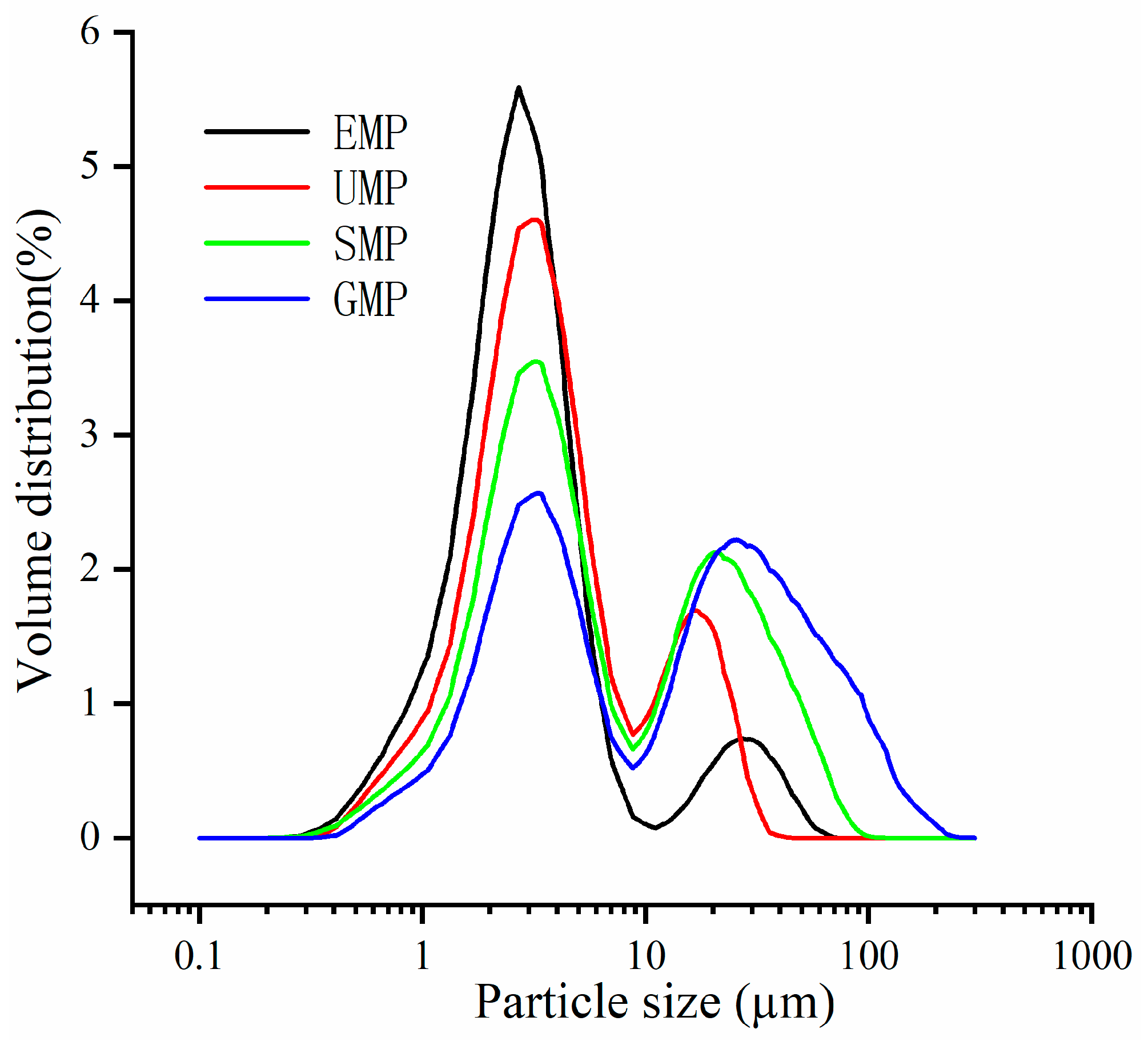
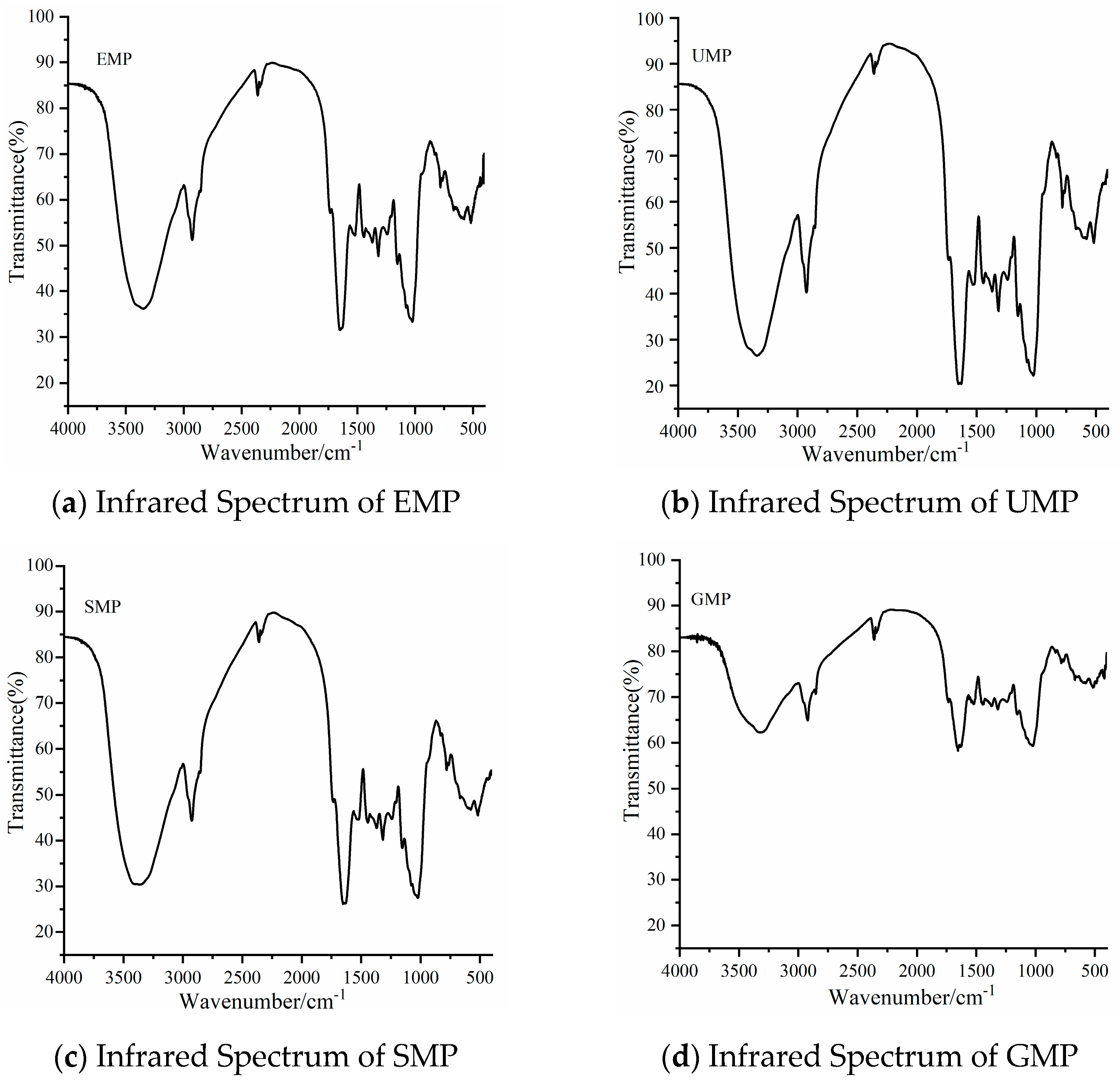
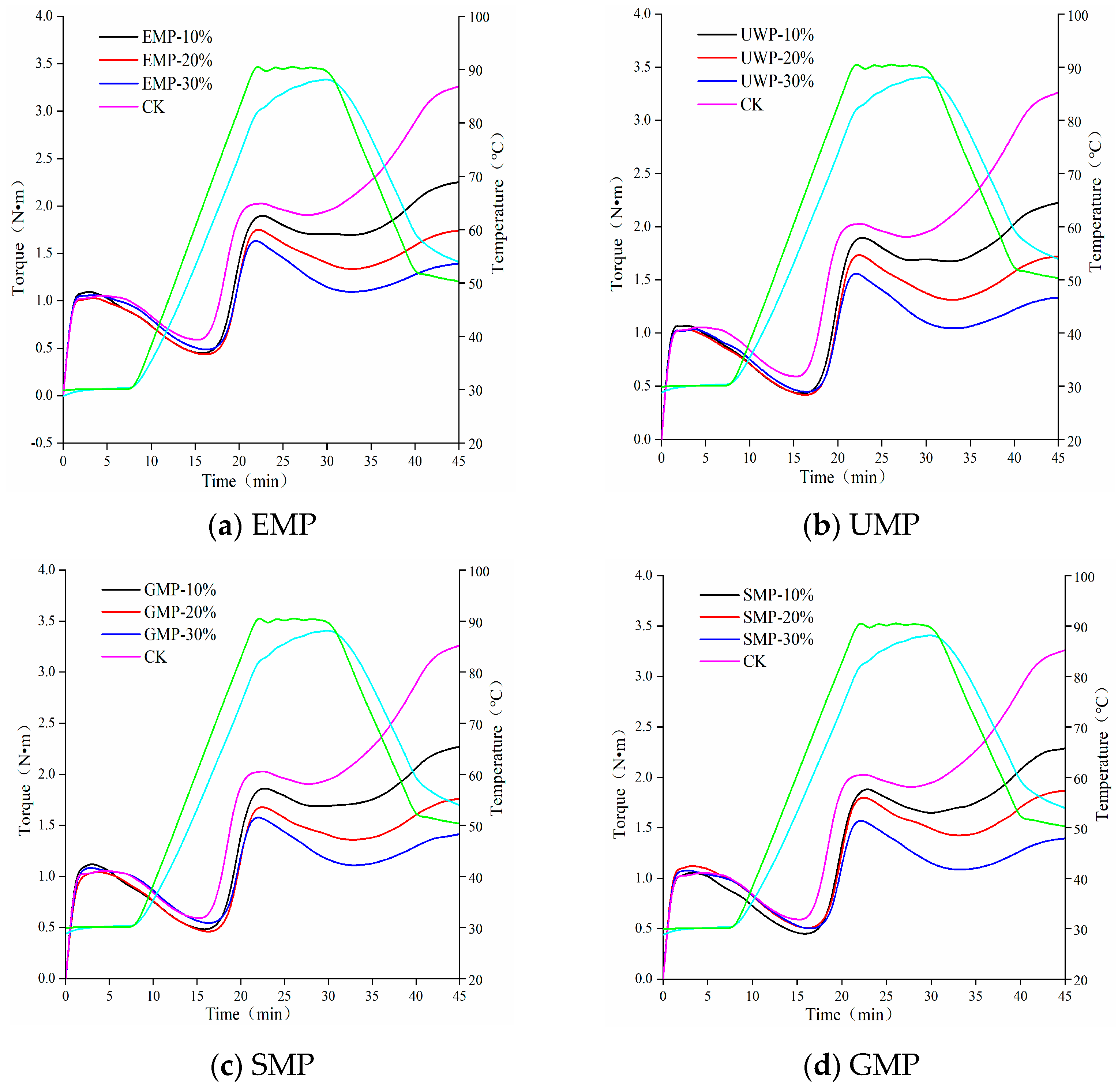

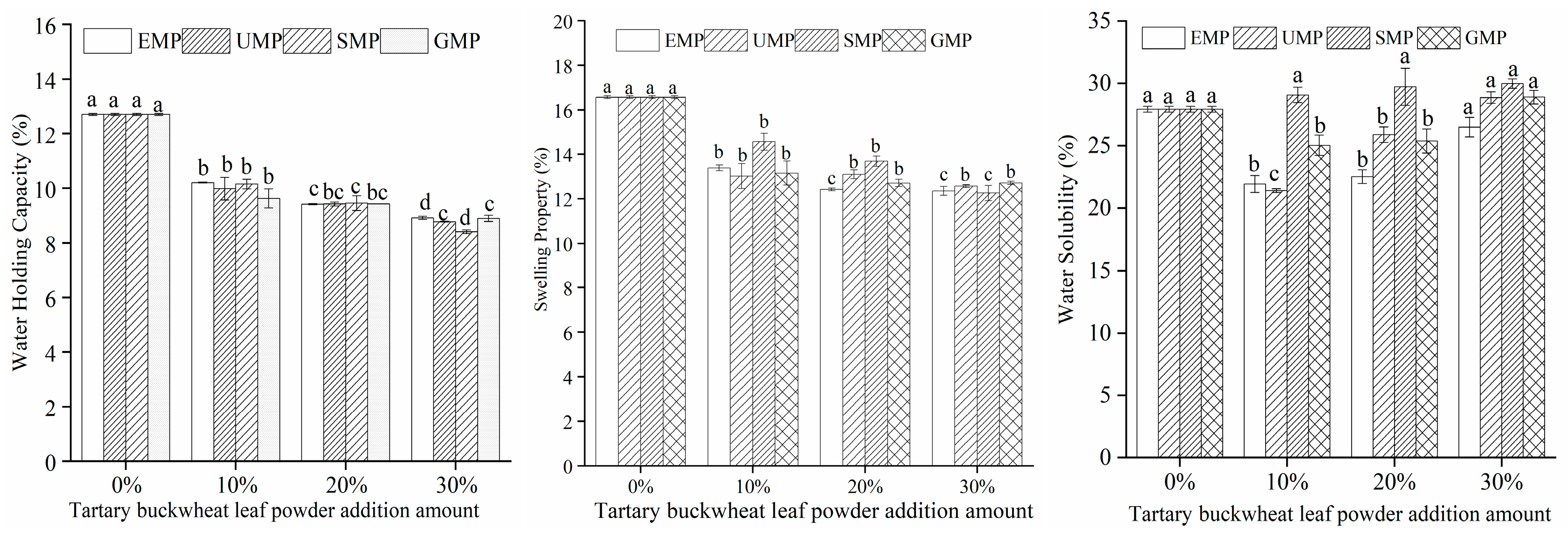
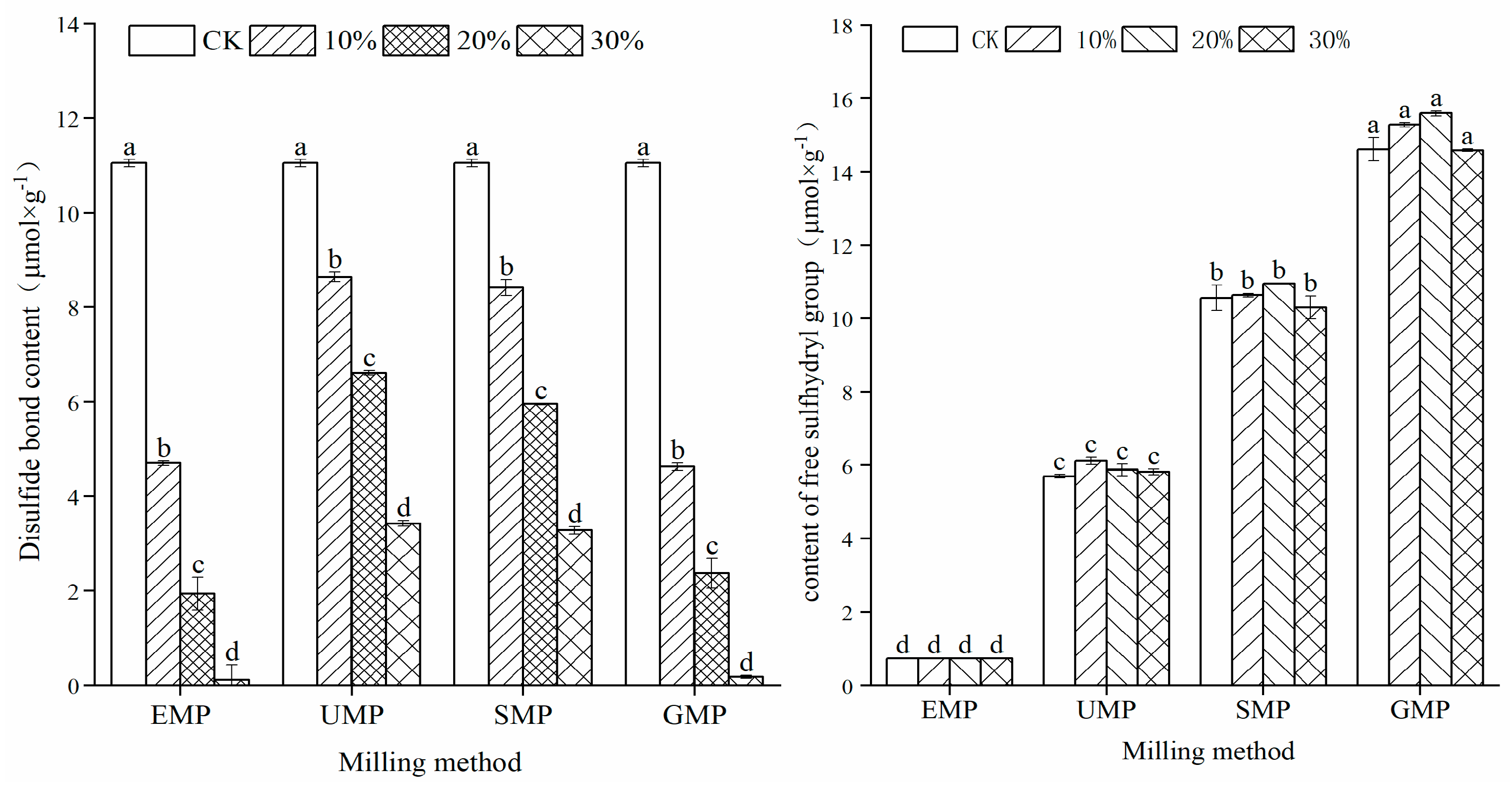




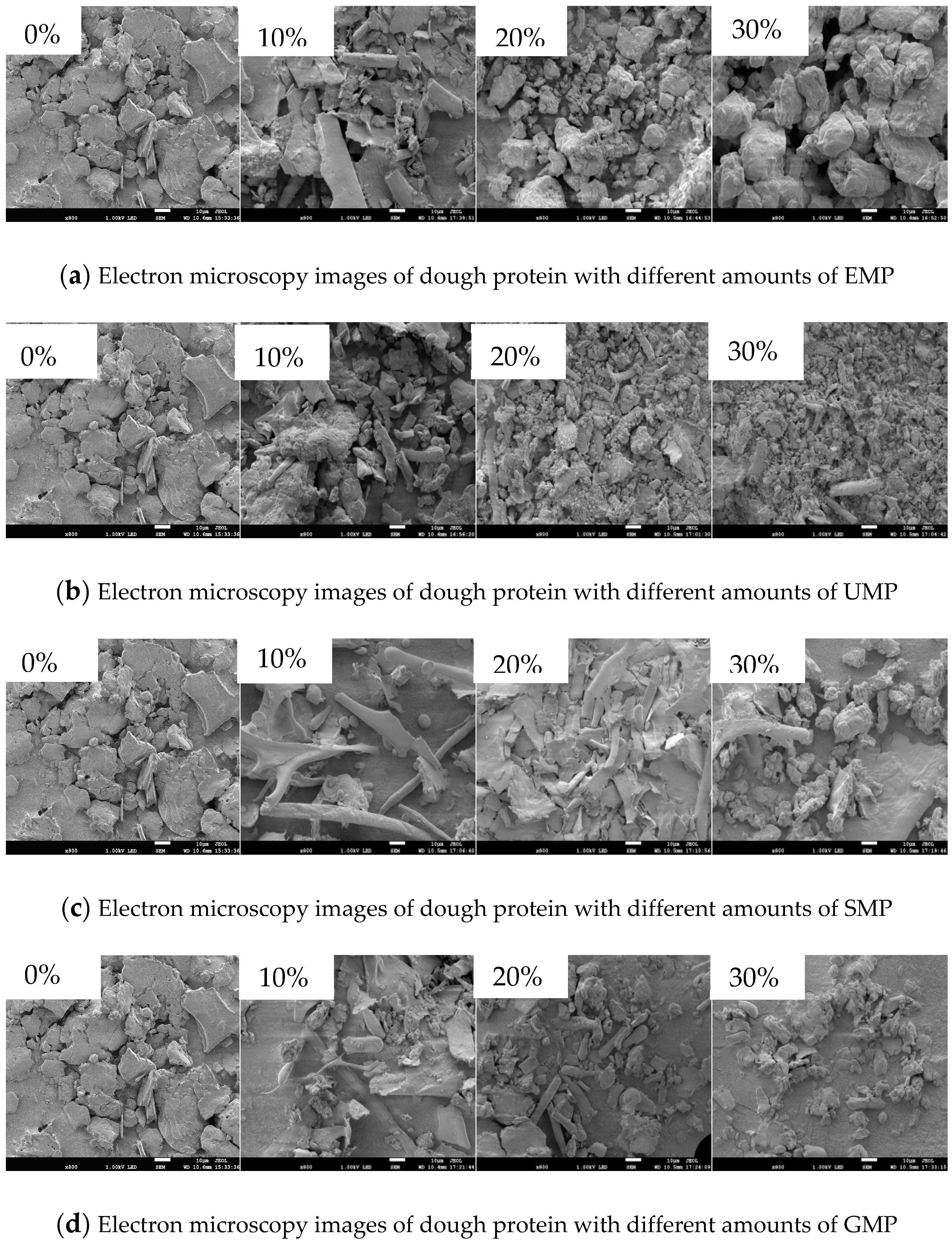
| Basal Component | Milling Method | |||
|---|---|---|---|---|
| EMP | UMP | SMP | GMP | |
| Ash content % | 11.37 ± 0.03 b | 11.05 ± 0.01 c | 10.60 ± 0.05 d | 11.79 ± 0.04 a |
| Protein % | 23.00 ± 0.27 bc | 24.11 ± 0.31 a | 22.37 ± 0.24 c | 23.53 ± 0.25 ab |
| Soluble dietary fiber % | 6.06 ± 0.03 c | 6.95 ± 0.07 a | 5.39 ± 0.09 d | 6.29 ± 0.02 b |
| Insoluble dietary fiber % | 22.44 ± 0.07 b | 21.58 ± 0.10 d | 22.84 ± 0.04 a | 22.17 ± 0.02 c |
| Rutin mg·100 g−1 | 4310 ± 0.57 c | 4853 ± 0.59 a | 4489 ± 0.67 b | 4333 ± 0.51 bc |
| Quercetin mg·100 g−1 | 110 ± 0.00 b | 160 ± 0.00 a | 110 ± 0.00 b | 120 ± 0.00 b |
| γ-aminobutyric acid mg·100 g−1 | 112 ± 0.87 bc | 119 ± 1.17 a | 107 ± 3.09 b | 114 ± 0.18 b |
| Chlorophyll mg·100 g−1 | 454 ± 0.00 bc | 540 ± 0.09 a | 469 ± 0.00 b | 443 ± 0.09 c |
| Milling Method | D50/μm | Specific Surface Area/m2·kg−1 | Cell Disruption Rate/% |
|---|---|---|---|
| EMP | 2.59 ± 0.05 d | 1057.7 ± 18.50 a | 386.8 ± 1.64 a |
| UMP | 3.27 ± 0.03 c | 868.9 ± 8.20 b | 305.7 ± 0.59 b |
| SMP | 4.37 ± 0.02 b | 683.8 ± 1.79 c | 296.7 ± 0.09 c |
| GMP | 13.65 ± 0.06 a | 496.2 ± 11.53 d | 73.6 ± 0.03 d |
| Milling Method | Water-Holding Capability g·g−1 | Water Solubility % | Swelling Property g·g−1 | |||
|---|---|---|---|---|---|---|
| 25 °C | 100 °C | 25 °C | 100 °C | 25 °C | 100 °C | |
| EMP | 5.28 ± 0.01 b | 6.81 ± 0.05 b | 20.42 ± 0.05 a | 30.95 ± 0.24 b | 3.25 ± 0.00 d | 3.06 ± 0.00 c |
| UMP | 4.45 ± 0.05 c | 4.78 ± 0.00 c | 19.82 ± 0.04 c | 29.37 ± 0.14 c | 3.43 ± 0.00 c | 3.12 ± 0.00 d |
| SMP | 4.24 ± 0.26 c | 4.86 ± 0.29 c | 20.10 ± 0.03 b | 32.27 ± 0.20 a | 4.08 ± 0.00 b | 4.64 ± 0.00 b |
| GMP | 6.65 ± 0.07 a | 9.87 ± 0.65 a | 18.06 ± 0.08 d | 24.43 ± 0.20 d | 5.23 ± 0.00 a | 7.15 ± 0.00 a |
| Sample | Water Absorption | Stable Time of Dough/min | C2/Nm | C3/Nm | C4/Nm | C5/Nm | C3–C4/ Nm | C5–C4/ Nm | α/ (Nm/min) | β/ (Nm/min) | γ/ (Nm/min) |
|---|---|---|---|---|---|---|---|---|---|---|---|
| CK | 60% ± 0.00 d | 7.95 ± 0.35 a | 0.59 ± 0.00 a | 2.03 ± 0.01 a | 1.93 ± 0.05 a | 3.26 ± 0.00 a | 0.10 m | 1.33 a | −0.06 ± 0.00 a | 0.56 ± 0.01 a | −0.02 ± 0.00 ab |
| EMP-10% | 70% ± 0.00 c | 5.35 ± 0.07 de | 0.45 ± 0.01 ef | 1.93 ± 0.03 b | 1.71 ± 0.03 b | 2.29 ± 0.07 b | 0.22 k | 0.58 b | −0.06 ± 0.01 a | 0.55 ± 0.01 b | −0.03 ± 0.04 bc |
| EMP-20% | 76% ± 0.00 b | 6.25 ± 0.07 b | 0.45 ± 0.03 ef | 1.81 ± 0.05 f | 1.36 ± 0.04 f | 1.78 ± 0.06 e | 0.45 e | 0.42 c | −0.07 ± 0.01 a | 0.35 ± 0.02 i | −0.05 ± 0.01 de |
| EMP-30% | 83% ± 0.00 a | 7.60 ± 0.00 a | 0.48 ± 0.00 d | 1.67 ± 0.00 i | 1.09 ± 0.00 i | 1.40 ± 0.00 gh | 0.58 a | 0.31 e | −0.07 ± 0.00 a | 0.31 ± 0.00 k | −0.07 ± 0.00 fg |
| UMP-10% | 70% ± 0.00 c | 5.50 ± 0.28 cd | 0.43 ± 0.00 g | 1.92 ± 0.01 b | 1.67 ± 0.00 c | 2.25 ± 0.03 c | 0.25 j | 0.58 b | −0.07 ± 0.00 a | 0.50 ± 0.04 e | −0.03 ± 0.02 abc |
| UMP-20% | 78% ± 0.00 b | 5.55 ± 0.35 cd | 0.41 ± 0.00 h | 1.75 ± 0.00 g | 1.31 ± 0.00 h | 1.72 ± 0.00 f | 0.44 f | 0.41 c | −0.06 ± 0.00 a | 0.40 ± 0.04 h | −0.05 ± 0.01 def |
| UMP-30% | 84% ± 0.00 a | 5.35 ± 0.21 de | 0.44 ± 0.00 f | 1.58 ± 0.01 k | 1.04 ± 0.00 k | 1.34 ± 0.01 i | 0.54 b | 0.30 e | −0.06 ± 0.00 a | 0.31 ± 0.00 k | −0.08 ± 0.01 g |
| SMP-10% | 70% ± 0.00 c | 5.44 ± 0.23 de | 0.44 ± 0.00 f | 1.90 ± 0.00 c | 1.64 ± 0.00 d | 2.29 ± 0.00 b | 0.26 i | 0.65 b | −0.06 ± 0.00 a | 0.54 ± 0.00 c | −0.01 ± 0.00 a |
| SMP-20% | 75% ± 0.00 b | 6.50 ± 0.00 b | 0.50 ± 0.00 c | 1.83 ± 0.01 e | 1.42 ± 0.00 e | 1.86 ± 0.01 d | 0.41 g | 0.44 c | −0.07 ± 0.01 a | 0.46 ± 0.00 f | −0.03 ± 0.00 bc |
| SMP-30% | 84% ± 0.00 a | 7.80 ± 0.14 a | 0.50 ± 0.00 c | 1.59 ± 0.00 j | 1.07 ± 0.01 j | 1.39 ± 0.02 h | 0.52 c | 0.32 de | −0.08 ± 0.01 a | 0.33 ± 0.03 j | −0.06 ± 0.01 efg |
| GMP-10% | 70% ± 0.00 c | 4.90 ± 0.00 e | 0.48 ± 0.00 d | 1.87 ± 0.00 d | 1.66 ± 0.02 c | 2.28 ± 0.01 b | 0.21 l | 0.62 b | −0.06 ± 0.00 a | 0.52 ± 0.01 d | -0.04 ± 0.00 cd |
| GMP-20% | 78% ± 0.00 b | 6.05 ± 0.07 bc | 0.46 ± 0.01 e | 1.71 ± 0.02 h | 1.34 ± 0.02 g | 1.74 ± 0.00 f | 0.37 h | 0.40 cd | −0.06 ± 0.01 a | 0.43 ± 0.05 g | −0.03 ± 0.01 bc |
| GMP-30% | 84% ± 0.00 a | 7.45 ± 0.21 a | 0.53 ± 0.00 b | 1.60 ± 0.00 j | 1.10 ± 0.00 i | 1.41 ± 0.00 g | 0.50 d | 0.31 e | −0.07 ± 0.00 a | 0.31 ± 0.02 k | −0.07 ± 0.01 g |
| Mill Method | Significance | Add the % of Tartary Buckwheat Leaf Powder | Significance | Mill Method * Add the % of Tartary Buckwheat Leaf Powder | Significance |
|---|---|---|---|---|---|
| Content of free sulfhydryl group | ** | Content of free sulfhydryl group | ** | Content of free sulfhydryl group | ** |
| Disulfide bond content | ** | Disulfide bond content | ** | Disulfide bond content | ** |
| Stable time of dough | ** | Stable time of dough | ** | Stable time of dough | ** |
| Water Holding Capacity | ns | Water-Holding Capacity | ** | Water-Holding Capacity | ns |
| Water Solubility | ** | Water Solubility | ** | Water Solubility | ** |
| Swelling Property | * | Swelling Property | ** | Swelling Property | * |
| C2 | ** | C2 | ** | C2 | ** |
| C3 | ** | C3 | ** | C3 | ** |
| C4 | ** | C4 | ** | C4 | ** |
| C5 | ** | C5 | ** | C5 | ** |
| C3–C4 | ** | C3–C4 | ** | C3–C4 | ** |
| C5–C4 | ns | C5–C4 | ** | C5–C4 | ns |
| α | ns | α | * | α | ns |
| β | ** | β | ** | β | ** |
| γ | ** | γ | ** | γ | ** |
| α-helix | ** | α-helix | ** | α-helix | ** |
| β-sheet | ** | β-sheet | ** | β-sheet | ** |
| β-turn | ** | β-turn | ** | β-turn | ** |
| random coil | ** | random coil | ** | random coil | ** |
Disclaimer/Publisher’s Note: The statements, opinions and data contained in all publications are solely those of the individual author(s) and contributor(s) and not of MDPI and/or the editor(s). MDPI and/or the editor(s) disclaim responsibility for any injury to people or property resulting from any ideas, methods, instructions or products referred to in the content. |
© 2024 by the authors. Licensee MDPI, Basel, Switzerland. This article is an open access article distributed under the terms and conditions of the Creative Commons Attribution (CC BY) license (https://creativecommons.org/licenses/by/4.0/).
Share and Cite
Feng, Y.; Zhu, J.; Li, Y.; Cheng, Z. Effects of Grinding Methods of Tartary Buckwheat Leaf Powder on the Characteristics and Micromorphology of Wheat Dough. Foods 2024, 13, 1233. https://doi.org/10.3390/foods13081233
Feng Y, Zhu J, Li Y, Cheng Z. Effects of Grinding Methods of Tartary Buckwheat Leaf Powder on the Characteristics and Micromorphology of Wheat Dough. Foods. 2024; 13(8):1233. https://doi.org/10.3390/foods13081233
Chicago/Turabian StyleFeng, Yuxia, Jiaying Zhu, Yunlong Li, and Zhe Cheng. 2024. "Effects of Grinding Methods of Tartary Buckwheat Leaf Powder on the Characteristics and Micromorphology of Wheat Dough" Foods 13, no. 8: 1233. https://doi.org/10.3390/foods13081233
APA StyleFeng, Y., Zhu, J., Li, Y., & Cheng, Z. (2024). Effects of Grinding Methods of Tartary Buckwheat Leaf Powder on the Characteristics and Micromorphology of Wheat Dough. Foods, 13(8), 1233. https://doi.org/10.3390/foods13081233




